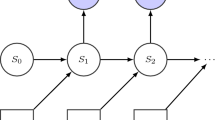Abstract
A new approach to on-line path planning is derived in this paper. The planning algorithm is motivated by robot navigation and manipulation tasks in uncertain, unstructured, dynamic environments. A minimum entropy evidential classifier is used to recognize targets and obstacles in the environment. An iterative Newton scheme is then used to generate a sequence of knot points that guide the motion of the robot. The acquisition and processing of sensory data continue during the motion, thus reducing the uncertainty about the environment. The classification of targets and obstacles is updated, and the path is replanned (locally) to adapt to those changes. A graphical tool based on the concept of Julia sets is used to ensure the predictability and smoothness of the paths.
Similar content being viewed by others
References
Chen, Y.C. and Vidyasagar, M., Optimal trajectory planning for planar n-link revolute manipulators in the presence of obstacles, Proc. IEEE Int. Conf. Robotics and Automation, 1988, pp. 202–208.
Chien, Y.P. Koivo, A.J. and Lee, B.H., On-line generation of collision free trajectories for multiple robots, Proc. IEEE Int. Conf. Robotics and Automation, 1988, pp. 209–214.
Dunlay, R.T., Obstacle avoidance perception processing for the autonomous land vehicle, Proc. IEEE Int. Conf. Robotics and Automation, 1988, pp. 912–917.
Erkmen, A.M. and Stephanou, H.E., Information fractals in evidential reasoning, Proc. IEEE Int. Symposium Intelligent Control, 1988.
Jun, S. and Shin, K.G., A probabilistic approach to collision-free robot path planning, Proc. IEEE Int. Conf. Robotics and Automation, 1988, pp. 220–225.
Kanayama, Y., Least cost paths with algebraic cost functions, Proc. IEEE Int. Conf. Robotics and Automation, 1988, pp. 75–80.
Kant, K. and Zucker, S., Planning collision-free trajectories in time-varying environments: a two level hierarchy, Proc. IEEE Int. Conf. Robotics and Automation, 1988, pp. 1644–1649.
KhatibO., Real-time obstacle avoidance for manipulators and mobile robots, International J. Robotics Res. 5 90–98 (1986).
Lozano-PerezT. and BrooksR.A., A subdivision algorithm in configuration space for findpath with rotation, IEEE Trans. on Systems, Man, and Cybernetics, Vol. SMC-15, No. 2, 1985, pp. 224–233.
LumelskyV.J., Algorithmic and complexity issues of robot motion in an uncertain environment, J. complexity 3 146–182 (1987).
PeitgenH.O. and RichterP.H., The Beauty of Fractals, Springer-Verlag, New York, 1986.
Rao, N.S.V., Iyengar, S.S. and deSaussure, G., The visit problem: visibility graph-based solution, Proc. IEEE Int. Conf. Robotics and Automation, 1988, pp. 1650–1655.
Shafer, G., A Mathematical Theory of Evidence, Princeton University Press, 1976.
StephanouH.E. and ErkmenA.M., Evidential classification of dexterous grasps, J. Robotic Systems 5 309–336 (1988).
Wilfong, G.T., Motion planning for an autonomous vehicle, Proc. IEEE Int. Conf. Robotics and Automation, 1988, pp. 529–533.
Yegenoglu, F., Erkmen, A.M. and Stephanou, H.E., One-line path planning under uncertainty, Proc. IEEE Conf. Decision and Control, 1988.
Author information
Authors and Affiliations
Rights and permissions
About this article
Cite this article
Erkmen, A.M., Yegenoglu, F. & Stephanou, H.E. Entropy-driven on-line control of autonomous robots. J Intell Robot Syst 2, 109–121 (1989). https://doi.org/10.1007/BF00238684
Received:
Issue Date:
DOI: https://doi.org/10.1007/BF00238684




